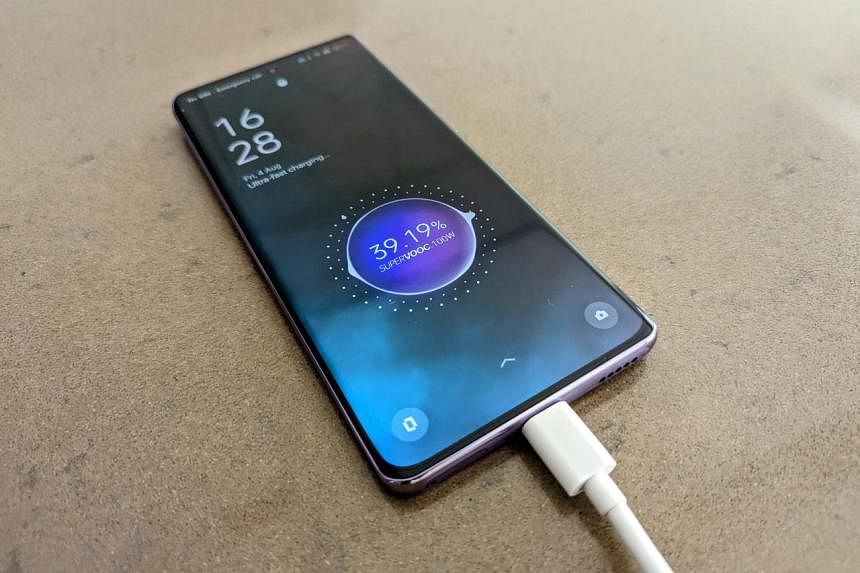SINGAPORE - Charging speeds for mobile phones have hit a new milestone: A phone can now be juiced from 0 per cent to 100 per cent in 25 minutes.
This breakthrough, achieved by a slate of new smartphones from Chinese makers, places their charging speeds well ahead of the offerings from big boys such as Samsung, Google and Apple.
Specifically, flagship models from Chinese smartphone makers Oppo, Honor and OnePlus come with the latest ultra-fast 100-watt chargers, which take just 25 minutes to achieve a full charge to last for a day’s use.
Wattage indicates the amount of electrical current pushed towards the phone; the higher the wattage, the higher the amount of energy and the faster the charge.
Comparatively, the latest flagship models of the big players, like the Samsung Galaxy S23 series, the Google Pixel 7 and Apple’s iPhone 14, generally use 20-watt to 45-watt chargers and can take more than an hour to achieve the same full charge.
For instance, the standard power brick for iPhones charges at 20 watts, and will fill up the device in around 1½ hours.
The latest of these fast-charging phones is the Oppo Reno10 Pro+, the first in the Chinese manufacturer’s line-up in Singapore to come with its 100-watt SuperVooc Flash Charge technology that can fully charge the phone in around 20 minutes.
Released in July, it follows other recent devices that also come with proprietary 100-watt fast chargers, like the Oppo Find X6, Honor Magic4 Pro and the OnePlus 11.
Oppo said its breakthrough comes from software upgrades in its latest in-house SuperVooc chipset that protects the battery from a high influx of electrical current.
Oppo Reno series senior product manager Joe Lin said the new SuperVooc S chip and accompanying software developed by Oppo allow lithium-ion batteries to safely receive high amounts of electrical current that are typically used for much bigger batteries.
OnePlus, which shares the same supply chain and manufacturing facilities as Oppo, uses similar software for regulating electrical current flow when the battery is almost full, to prevent overcharging and overheating.
Similar to Oppo, its latest fast-charging phones use a dual battery system, with each battery receiving half the wattage from the 100-watt charger to fast-charge safely, said a spokesman for OnePlus.
Honor said it also uses software to regulate the influx of electrical current, but declined to comment on whether it built its own fast-charging technology and on its development, citing internal policies.
During charging, lithium ions are shuttled between two layers of electrodes – typically graphite and metal oxides (such as lithium manganese oxide) – inside a battery, creating a flow of electrons that powers a device.
New lithium-ion batteries are using more silicon-based materials to improve the structure’s resistance to warping, and manganese-based materials to stretch the lifespan of batteries.
The capacity of lithium-ion batteries is reduced – what is known as battery fade – when a battery is overcharged, causing it to heat up, said Dr Chiam Sing Yang, deputy executive director of the Agency for Science, Technology and Research’s Institute of Materials Research and Engineering.
Overcharging typically happens after the 80 per cent charged mark if the flow of current is not regulated well.
“Battery management software today can prevent too much current from passing through the battery,” he said.
Battery fade can also occur during fast-charging, when electrical current passes through its layers too quickly and the lithium ions that are in the bottom of the battery do not get time to charge up and move between the layers, said Dr Chiam, who is also the technical director of the Singapore Battery Consortium, an innovation group for battery development.
He noted that the lithiums left behind will become “dead” over time.
This problem can be overcome by battery management software.
Oppo’s Mr Lin said that in the case of Oppo, its software is able to track in real time the activity of the bottom lithium ions inside the battery to adjust the charging current to minimise the risk of dead lithiums, prolonging the battery’s lifespan.
The Oppo Reno10 Pro+ and the latest 100-watt charging phones by Honor also stop charging once the phone’s battery is full, such as during overnight charging.
Experts warned that ultra-fast chargers should not be used for older devices that are not installed with such advance charging management software to prevent damage to their batteries.
Phones today have gradually overcome major bottlenecks to faster charging by building safer batteries with a better balance of materials and better software, said Associate Professor Xu Yan from the Nanyang Technological University’s School of Electrical and Electronic Engineering.
He said: “I think Chinese smartphone manufacturers are usually faster adopters of new technologies over other brands. Over the years, they have invested significant resources in both software and hardware.”


